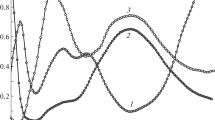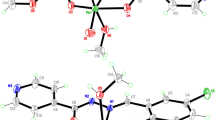Summary
The interaction of hard base chelating agents (LH) such as 8-quinolinol (oxH), salicylaldehyde (salH) andN-nitrosophenylhydroxylamine (NphaH) with ammonium tetrathiomolybdate(VI), (1), in aqueous solution yields disulphidomolybdenum(VI) complexes, [MoS2L2]. The i.r. absorptions at 540 and 510 cm−1 are assigned tov(Mo-S), which indicate that the two sulphido-groups arecis to each other, The interaction of (1) with soft base chelating agents (SS), such as dithiocarbamates (dtc), dithiophosphate (dtp) and xanthates (xan) yields dimeric sulphido-bridged sulphidomolybdenum(V) complexes, [Mo2S4(SS)2] and with potassium ethylthioxanthate (KEttxan) yields a molybdenum(IV) complex, [Mo(Ettxan)4]. The [Mo2S4(R2dtc)2] complexes were also obtained by the interaction of [MoO2(R2dtc)2] with phosphorus pentasulphide in xylene. It was concluded that tetrathiomolybdate(VI) undergoes facile reduction when compared with tetraoxomolybdate(VI).
Similar content being viewed by others
References
E. I. Stiefel,Prog. Inorg. Chem., 22, 1 (1977).
K. B. Swedo and J. H. Enemark,J. Chem. Educ., 56, 70 (1979).
E. I. Stiefel in H. F. Barry and P. C. H. Mitchell, (Eds.)Proc. Int. Conf. on the Chemistry and Uses of Molybdenum, Climax Molybdenum Co., Michigan, 1982.
S. P. Cramer, W. O. Gillum, K. O. Hodgson, L. E. Mortenson, E. I. Stiefel, J. R. Chisnell, W. J. Brill and V. K. Shah,J. Am. Chem. Soc., 100, 3814 (1978).
K. S. Nagaraja,Ph.D. Thesis, Indian Institute of Technology, Madras, India, 1982.
A. Müller, E. Diemann and C. K. Jorgensen,Structure and Bonding, 14, 23 (1973).
K. S. Nagaraja and M. R. Udupa,Polyhedron, 4, 649 (1985).
K. S. Nagaraja and M. R. Udupa,Ind. J. Chem., (in press).
W. Andruchow and R. D. Archer,J. Inorg. Nucl. Chem., 34, 3185 (1972).
R. C. Charles, H. Prieser, R. Prielel, L. E. Hillard and W. D. Johnston,Spectrochim. Acta, 8, 1 (1956).
J. P. Phillips,Spectra-Structure Correlation, Academic Press, New York, 1964.
R. N. Hazeldine, J. Jander and P. Taste,J. Chem. Phys., 23, 979 (1975).
L. J. Bellamy,The Infrared Spectra of Complex Molecules, Wiley, New York, 1957.
E. Diemann and A. Müller,Coord. Chem. Rev., 10, 79 (1973).
A. Müller, B. Krebs, R. Kebaciaglu, M. Stockberger and O. Glemser,Spectrochim. Acta, 24A, 1831 (1968).
M. R. Udupa and K. S. Nagaraja,Thermochim. Acta, 58, 117 (1982).
For cyclic voltammetry details, see Ref. 7, [Mo2S4(Et2dtc)2] (obtained by method B) exhibited two reduction peaks at −0.97 and −1.27Vvs. SCE.
M. L. Sankaranarayana and C. C. Patel,Can. J. Chem., 39, 1633 (1961).
J. Hyde, K. Venkatasubramanian and J. Zubieta,Inorg. Chem., 17, 414 (1978).
E. Hofer, W. Holzbach and K. Wieghhardt,Angew. Chem. Int. Ed. Engl., 20, 282 (1981).
K. Wieghhardt, M. Hahn, J. Weiss and W. Swindoff,Z. Anorg. Allg. Chem., 492, 164 (1982).
F. A. Schultz, V. R. Ott, D. S. Rollison, D. C. Bravard, J. W. McDonald and W. E. Newton,Inorg. Chem., 17, 1758 (1978).
A. Müller, R. G. Bhattacharya, N. Mohan and B. Pfefferkorn,Z. Anorg. Allg. Chem., 454, 118 (1979).
R. N. Jowitt and P. C. H. Mitchell,Chem. Comm., 605 (1966).
S. Brislow, D. Collison, C. D. Garner and W. Clegg,J. Chem. Soc., Dalton Trans., 2495 (1983).
A. Nakmura, M. Nakayama, K. Sugihashi and S. Otsuka,Inorg. Chem., 18, 394 (1979).
W. E. Newton, J. L. Corbin and J. W. McDonald,J. Chem. Soc., Dalton Trans., 1044 (1974).
K. S. Nagaraja and M. R. Udupa,Transition Met. Chem., 8, 191 (1983).
Author information
Authors and Affiliations
Rights and permissions
About this article
Cite this article
Nagaraja, K.S., Udupa, M.R. Reactivity of the tetrathiomolybdate(VI) anion towards hard and soft base chelating agents. Transition Met Chem 11, 217–220 (1986). https://doi.org/10.1007/BF00619472
Received:
Issue Date:
DOI: https://doi.org/10.1007/BF00619472




